 W
WWilhelm Sebastian von Belling was a Prussian Hussar general under Frederick the Great.
 W
WKasimir Wedig von Bonin also called Casimir Wedigo von Bonin) was a Prussian lieutenant general during the reigns of Frederick William I and his son, Frederick the Great.
 W
WKaspar Ludwig von Bredow was a Prussian lieutenant general, Knight of the Black Eagle Order, recipient of the Order Pour le Mérite and heir to Ihlow. He is regarded as one of the Crown Prince Frederick's military mentors.
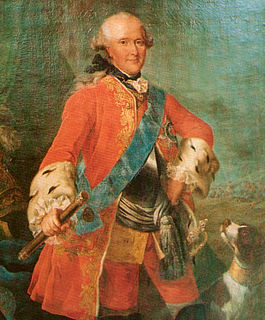 W
WFerdinand, Prince of Brunswick-Lüneburg, was a German-Prussian field marshal (1758–1766) known for his participation in the Seven Years' War. From 1757 to 1762 he led an Anglo-German army in Western Germany which successfully repelled French attempts to occupy Hanover.
 W
WWilhelm Dietrich Freiherr von Buddenbrock was a Prussian Generalfeldmarschall and cavalry leader.
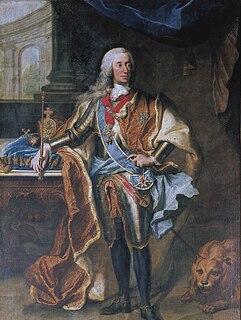 W
WCharles VII was the prince-elector of Bavaria from 1726 and Holy Roman Emperor from 24 January 1742 to his death. He was a member of the House of Wittelsbach, and his reign as Holy Roman Emperor thus marked the end of three centuries of uninterrupted Habsburg imperial rule although he was related to the Habsburgs by both blood and marriage. After the death of emperor Charles VI in 1740, he claimed the Archduchy of Austria by his marriage to Maria Amalia of Austria, the niece of Charles VI, and was briefly, from 1741 to 1743, as Charles III King of Bohemia. In 1742, he was elected emperor of the Holy Roman Empire as Charles VII and ruled until his death three years later.
 W
WKarl Wilhelm von Dieskau was a Prussian lieutenant general and general inspector of the artillery. He participated in twelve campaigns, ten battles, nine sieges. He received the Black Eagle Order, the Order Pour le Mérite, and was included in 1851 on the Equestrian statue of Frederick the Great. He is general credited with creating Frederick the Great's vaunted horse artillery.
 W
WFriedrich Wilhelm von Dossow was a Prussian Generalfeldmarschall and Governor of Wesel.
 W
WPeter Ludwig du Moulin was a Prussian General of Infantry and served Frederick the Great during the War of Austrian Succession (1740–1748). He served three Prussian kings, including Frederick, Frederick William I, and Frederick I, and fought in the major Prussian wars of the first half of the eighteenth century. During 1730–1731, he was quartermaster of the Prussian field armies. From 1741–1755, he was proprietor of the Infantry Regiment Nr. 37.
 W
WKarl Wilhelm Reichsgraf Finck von Finckenstein was a Count of the Holy Roman Empire of the German Nation, a Prussian diplomat, and later Prime Minister of Prussia.
 W
WFrederick II was a Prussian royal, military leader, writer, and composer who was King of Prussia from 1740 until his death in 1786. He was the longest reigning monarch of the House of Hohenzollern. His most significant accomplishments during his reign included his military successes in the Silesian wars, his reorganisation of the Prussian Army, the First Partition of Poland, and his patronage of the arts and the Enlightenment. Frederick was the last Hohenzollern monarch titled King in Prussia and declared himself King of Prussia after annexing Polish Prussia from the Polish–Lithuanian Commonwealth in 1772. Prussia greatly increased its territories and became a leading military power in Europe under his rule. He became known as Frederick the Great and was nicknamed "The Old Fritz" by the Prussian people and eventually the rest of Germany.
 W
WFrederick William II, Duke of Schleswig-Holstein-Sonderburg-Beck was a Duke of Schleswig-Holstein-Sonderburg-Beck. He served as Prussian field marshal and was appointed Governor of Berlin, but never filled the latter position.
 W
WFriedrich Leopold Graf von Gessler (or Geßler; was a Prussian Generalfeldmarschall and one of Frederick the Great's most famous cavalry generals.
 W
WCaspar Otto von Glasenapp was a Prussian officer, most recently Generalfeldmarschall.
 W
WHeinrich Sigismund von der Heyde was a Prussian officer and commander-in-chief of Kolberg. His name is spelled variously "von der Heyden" and "von Heyden". He is best known for his tenacious defense of Kolberg during its three sieges of the Seven Years' War. He received the Pour le Merite and he is immortalized on the Equestrian statue of Frederick the Great.
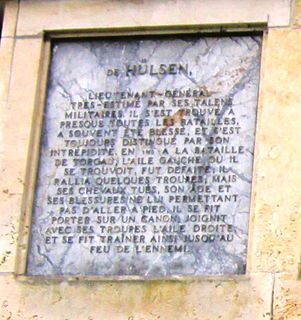 W
WJohann Dietrich von Hülsen was a Prussian lieutenant general of the infantry. After a lifelong officer's career in various infantry regiments, he acquired the special respect of Frederick II in the Seven Years' War as general, and was honored by him with the appointment as governor of Berlin. During the war, he became a canon to Minden and was awarded the Black Eagle Order and the Order Pour le Mérite. His name appears on the top tier of the Equestrian statue of Frederick the Great.
 W
WFriedrich Wilhelm Gottfried Arnd von Kleist, was a royal Prussian officer, who rose to the rank of major general. In the Seven Years' War, he organized and commanded the Freikorps Kleist. He was also known as Green Kleist for his command of the Green Hussar regiment, and to distinguish him from the 58 other members of the Kleist family who served in the war. He received the Order Pour le Mérite and he was listed on the Equestrian Statue of Frederick the Great.
 W
WHans von Lehwald(t), also known as Johann von Lehwald(t), was a Prussian Generalfeldmarschall. He joined the military in 1700 and participated in all Prussian field operations from the War of Spanish Succession through the Seven Years' War. He served with particular distinction in Frederick the Great's war with the Austrians in the Silesia and Seven Years' War.
 W
WRobert Scipio, Freiherr von Lentulus was a military officer, first in Austrian service, later in Prussian service. He was among Frederick the Great's trusted officers, and served him not only in military capacity but as a diplomat and, later, a governor of Neuchâtel. He was proprietor of a Prussian cavalry regiment in the years 1758–1778.
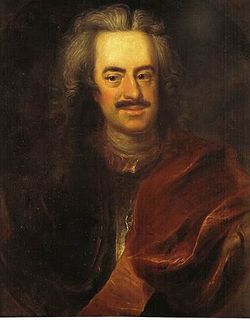 W
WLeopold I, Prince of Anhalt-Dessau was a German prince of the House of Ascania and ruler of the principality of Anhalt-Dessau from 1693 to 1747. He was also a Generalfeldmarschall in the Prussian army. Nicknamed "the Old Dessauer", he possessed good abilities as a field commander, but was mainly remembered as a talented drillmaster who modernized the Prussian infantry.
 W
WLeopold II Maximilian, Prince of Anhalt-Dessau, was a German prince of the House of Ascania and ruler of the principality of Anhalt-Dessau from 1747 to 1751; he also was a Prussian general.
 W
WHans Sigismund von Lestwitz was a Prussian major general of the infantry and was especially honored by Frederick II for his action in the Battle of Torgau. His decisive leadership at Torgau, in which he snatched victory from defeat, was credited at the time and subsequently with saving the Prussian state. Frederick acknowledged his action with the post-war gift of vast estates near Kunersdorf.
 W
WChristian Nicolaus von Linger was a Prussian general. He was chief of the Prussian artillery from 1716. In his 67-year military career, he served three monarchs in six wars, and founded the Prussian artillery arm of the military. He was appointed the first general of artillery by King Frederick II in 1744.
 W
WHeinrich von Manteuffel, was a Prussian lieutenant general. He participated in the Pomeranian campaign of 1715 and the first two of Frederick's Silesian wars, was wounded at Chotusitz, and commanded an infantry regiment at the beginning of the Seven Years' War. He received the Order of the Black Eagle, the Order Pour le Merite and his name is inscribed on the Equestrian statue of Frederick the Great.
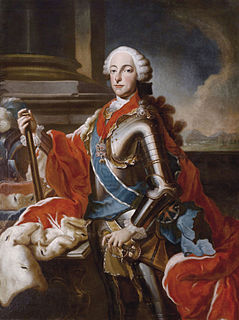 W
WMaximilian III Joseph, "the much beloved", was a Prince-elector of the Holy Roman Empire and Duke of Bavaria from 1745 to 1777.
 W
WKarl Friedrich von Moller was a Prussian colonel of artillery. His uncanny genius at setting up artillery parks gave Frederick the Great high confidence in the artillery's ability to effect the outcome. During the Seven Years' War, Moller gained great fame specifically for his actions at Lobositz, Rossbach and Zorndorf.
 W
WGustav Bogislav von Münchow was a Prussian general. In the early years of the reign of Frederick the Great, Münchow was not only a soldier and a diplomatic confidant, but he also earned a reputation for the improvement of Prussian military medical care. He was honored with the Black Eagle Order and his name is listed on the Equestrian statue of Frederick the Great.
 W
WDubislav Friedrich von Platen was a Prussian officer in Frederick the Great's army. A cavalry general, he was also Governor of Königsberg, a Knight of the Order of Saint John, and a recipient of the Order of the Black Eagle. An active cavalry officer in all of the wars fought by Frederick—the War of Austrian Succession, the Second Silesian War, the Seven Years' War and, finally, the War of Bavarian Succession — he was commemorated on Equestrian statue of Frederick the Great in 1851 erected by Frederick's great-great nephew, Frederick William IV.
 W
WHans Friedrich von Platen was a royal Prussian general of the cavalry. While in service in the Prussian Army, he fought in the Great Turkish War, the War of Spanish Succession and the Great Northern War. Both of his sons were Prussian generals,; the youngest, Dubislav Friedrich von Platen, was a trusted and successful general of Frederick the Great.
 W
WJoachim Bernhardt von Prittwitz and Gaffron (1726–1793) was a Prussian officer credited with saving the life of Frederick the Great at the Battle of Kunersdorf. At the time, he was a cavalry captain in Hans Joachim von Zieten's Hussar regiment. He became the head of gendarmes regiment, and inspector general of the cavalry of Brandenburg March and Magdeburg in 1775. He was promoted to lieutenant general in 1785 and general of cavalry in 1788. Frederick awarded him the Order Pour le Mérite and the Order of the Black Eagle. In 1851, Prittwitz was included on the panels of the Equestrian statue of Frederick the Great as one of the key figures in the establishment of the Prussia state.
 W
WGeorg Ludwig of Puttkamer was a Prussian major general and squire of Pawonków and Pietrowice in Upper Silesia; he came from the Pomeranian noble family of Puttkamer.
 W
WFrederick Augustus, Count Rutowsky, was a Saxon Field Marshal who commanded Saxon forces in the Siege of Pirna during the Seven Years' War.
 W
WChristian Louis Casimir, 2nd Count of Sayn-Wittgenstein-Berleburg-Ludwigsburg was a reigning Count of Sayn-Wittgenstein-Berleburg-Ludwigsburg line of Sayn-Wittgenstein family from 1750 to 1796.
 W
WKurt Christoph, Graf von Schwerin was a Prussian Generalfeldmarschall, one of the leading commanders under Frederick the Great.
 W
WFriedrich Wilhelm August Heinrich Ferdinand von Steuben, also referred to as Baron von Steuben, was a Prussian and later an American military officer. He served as Inspector General and a Major General of the Continental Army during the American Revolutionary War. He was one of the fathers of the Continental Army in teaching them the essentials of military drills, tactics, and discipline. He wrote Regulations for the Order and Discipline of the Troops of the United States, the book that served as the Army's drill manual for decades. He served as General George Washington's chief of staff in the final years of the war. In 1780, von Steuben was elected a member of the American Philosophical Society.
 W
WJoachim Friedrich von Stutterheim („Alt-Stutterheim“),. He was known as the Old Stutterheim to distinguish him from his younger brother, Otto Ludwig (1718–1780), also a lieutenant general in Frederick the Great's army.
 W
WCarl Heinrich von Wedel was a Prussian lieutenant general in the War of Austrian Succession (1740–1748), the Seven Years' War (1756–1763), and the War of Bavarian Succession (1778–1779). He fought most notably in the Battle of Tornow in 1758, and the Battle of Kay in 1759. He was instrumental in Frederick the Great's victory at Leuthen in December 1757.
 W
WJohann Adolf II, Duke of Saxe-Weissenfels, was the last duke of Saxe-Weissenfels-Querfurt and a member of the House of Wettin. He was also a commander in the Saxon army.
 W
WJohann Paul von Werner was chief of the Prussian Hussar Regiment No. 6 ; he also received the Prussian Order Pour le Mérite. Initially in Austrian service, he fought against Spain, France, the Ottoman Empire and against Prussia. One of Frederick the Great's trusted diplomats, Hans Karl von Winterfeldt, recruited him into Prussian service in 1750; subsequently, he fought for Prussia against the Austrians in the Seven Years' War and the War of Bavarian Succession. He was wounded once, and taken prisoner several times. The Prussian playwright Gotthold Lessing modeled the character of the sergeant in his Minna von Barnhelm on Werner.
 W
WHans Karl von Winterfeldt, a Prussian general, served in the War of the Polish Succession, the War of Austrian Succession, Frederick the Great's Silesian wars and the Seven Years' War. One of Frederick's trusted confidantes and advisors, he attracted enmity from other courtiers. Frederick entrusted him with considerable autonomy on the general staff, and Winterfeldt developed the first "modern" program of military intelligence gathering. He negotiated the Convention of Westminster and, for his efforts on Frederick's behalf, received the Order of the Black Eagle and the Order Pour le Mérite. He died from wounds received at Battle of Moys. His name is included on the Equestrian statue of Frederick the Great.
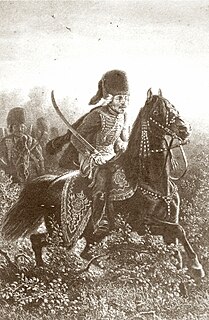 W
WHans Joachim von Zieten, sometimes spelled Johann Joachim von Ziethen,, also known as Zieten aus dem Busch, was a cavalry general in the Prussian Army. He served in four wars and was instrumental in several victories during the reign of Frederick the Great, most particularly at Hohenfriedberg and Torgau. He is also well known for a raid into the Holy Roman Empire during the Second Silesian War, known as Zieten's Ride. After engaging in a reputed 74 duels, and fighting in four wars, he died in his bed at the age of 86.